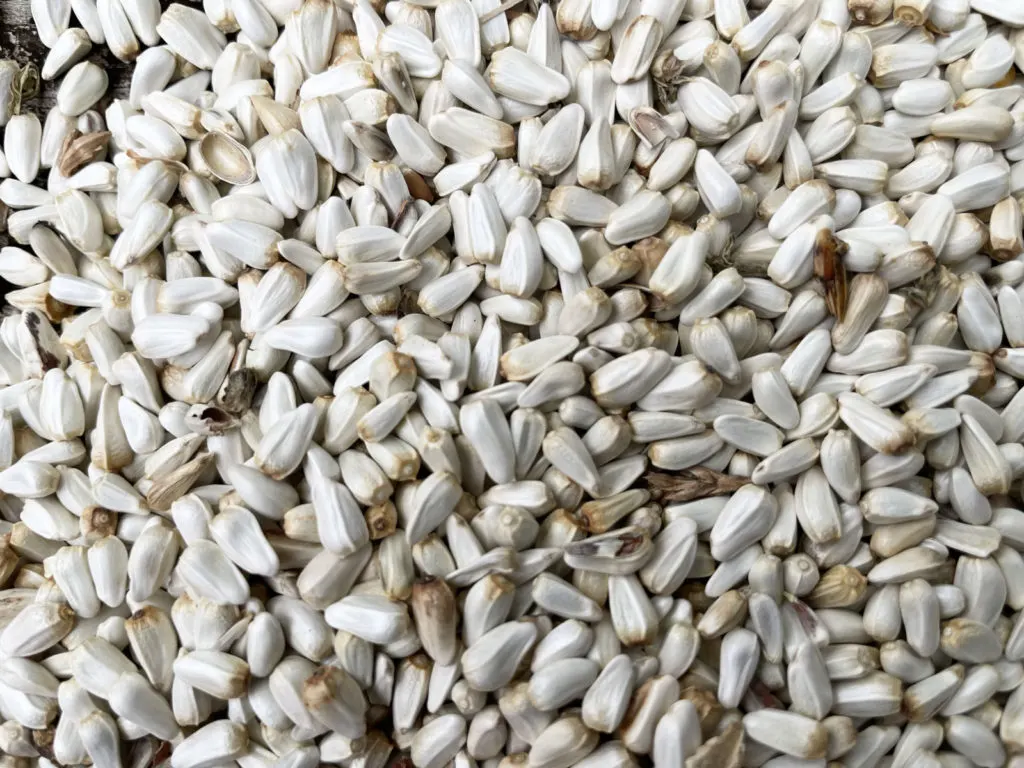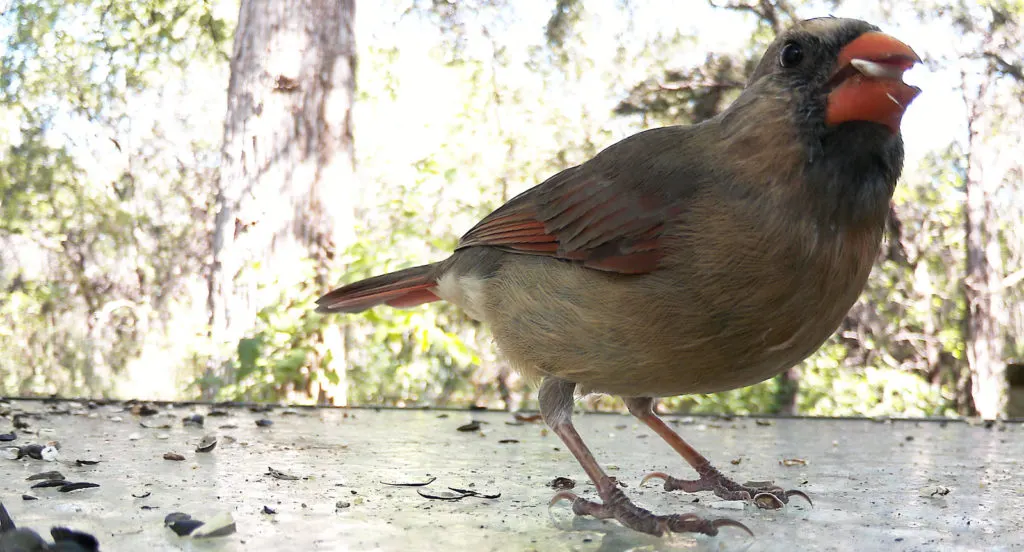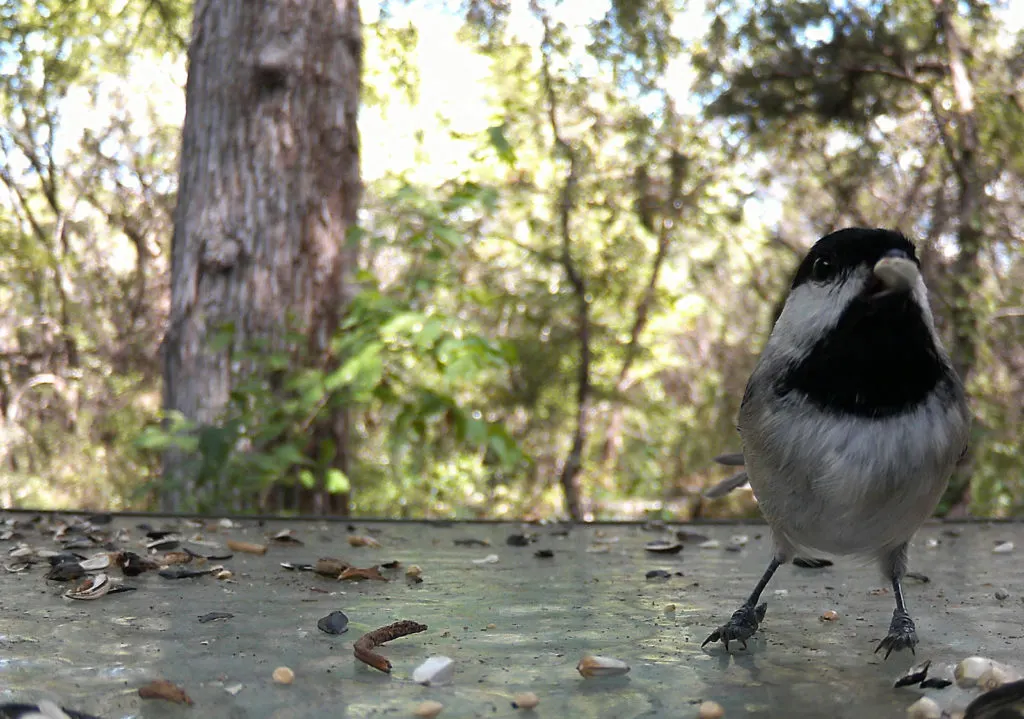Safflower is a highly valued crop known for its oil-rich seeds. Beyond its culinary and industrial uses, safflower seeds have carved a niche in the bird feeding community due to their unique properties. If you’re considering it for your bird feeding station, let’s look at what safflower is, the types of birds it attracts–and the birds that will probably just leave it alone.

What is Safflower?
Safflower is a thistle-like plant with a rich history, dating back to ancient Egypt. It’s primarily cultivated for its seeds, which produce an oil used in cooking and in the manufacturing of paints and varnishes.
However, it’s the safflower seeds that interest bird enthusiasts the most. It’s loved by several species of birds–and disliked by birds that some classify as “bully birds,” helping to keep bird seed available in your feeders and safe from hungry flocks that would otherwise mob the feeder.
It’s also a very light-colored seed, easily seen by birds, making it a good draw to your feeding station.
Birds Attracted by Safflower Seeds

Safflower seeds are particularly appealing to a variety of birds due to their nutritional content. Birds that are commonly attracted to safflower include:
- Cardinals: These easy to identify red birds are perhaps the most famous fans of safflower seeds! They are the ones we see eating the safflower most often at our feeders.

- Chickadees: Small yet fearless, chickadees readily accept safflower seeds. Just as with sunflowers seeds, watch for the chickadees to grab a safflower seed then head off to a nearby tree to enjoy it alone.
- Doves: Doves enjoy pecking on these nutritious seeds (especially when you scatter some on the ground.)
- Nuthatches: With their upside-down feeding antics, nuthatches find safflower seeds worth the effort.
- Grosbeaks: Their large beaks make it easy for them to crack open safflower seeds.
Nutritional Benefits
Safflower seeds are rich in fat, protein, and fiber, making them an excellent energy source for birds. The high fat content is particularly beneficial during the winter months, providing the necessary calories to keep birds warm.
Which Birds Don’t Like Safflower Seeds?
Safflower seeds, known for their bitter taste, are not universally loved by all bird species–and that can be a good thing! This selective preference can be a good way to discourage certain birds without using physical barriers.
Birds that typically do NOT like safflower seeds include:
- European Starlings: Often considered pests due to their aggressive feeding habits and tendency to flock in large numbers, starlings typically avoid safflower seeds.
- House Sparrows: Like starlings, house sparrows are often viewed as invasive and can dominate feeders, pushing out native species. They generally do not prefer safflower seeds.
- Common Grackles: These birds, known for their iridescent black plumage and gregarious nature, are also less likely to eat safflower seeds due to their taste.
It’s worth mentioning that squirrels, which are unwelcome at some bird feeders due to their appetite and destructive behavior, do not like safflower seeds! This makes safflower an excellent choice for those looking to discourage these squirrels to leave the bird feeder alone.
How to Store Safflower Seeds
Proper storage of safflower seeds, just like storing any bird seeds, is crucial to maintain their freshness and nutritional value. Here are some tips for storing safflower seeds effectively:
- Airtight Containers: Store the seeds in airtight containers to protect them from moisture and pests. Metal or sturdy plastic containers with secure lids work best.
- Cool and Dry Location: Keep the storage containers in a cool, dry place. Avoid areas prone to temperature fluctuations or high humidity, which can spoil the seeds.
- Elevated Storage: If possible, place the containers off the ground to deter mice and other rodents.
Special Considerations
When incorporating safflower seeds into your bird feeding routine, keep the following considerations in mind:
- Transition Gradually: If your birds are new to safflower seeds, mix them with other seeds initially to encourage acceptance.
- Feeder Compatibility: Safflower seeds can be used in most types of feeders. However, they are particularly well-suited for tube feeders or hopper feeders, which protect the seeds from the elements.
- Monitor Consumption: Observe which birds are visiting your feeder and how quickly they consume the safflower seeds. This can help you adjust the amount you provide and minimize waste.
- Pairing with Other Seeds: While safflower seeds have a selective appeal, pairing them with other types of seeds in separate feeders can attract a wider variety of birds to your yard.
Safflower seeds offer a unique blend of nutritional benefits and selective appeal, making them a valuable addition to any backyard bird feeder. By attracting a variety of desirable birds while naturally deterring common pests, safflower allows enthusiasts to enjoy the beauty and diversity of bird life up close.
More Posts You Might Like
What is the Best Wild Bird Seed to Buy?
What Color Bird Feeder Attracts the Most Birds?
Is It OK to Put Bird Seed on the Ground?
- 8 Letter Bird Names - August 14, 2024
- 7 Letter Bird Names - August 14, 2024
- 7 Birds Named After Famous People - July 23, 2024
